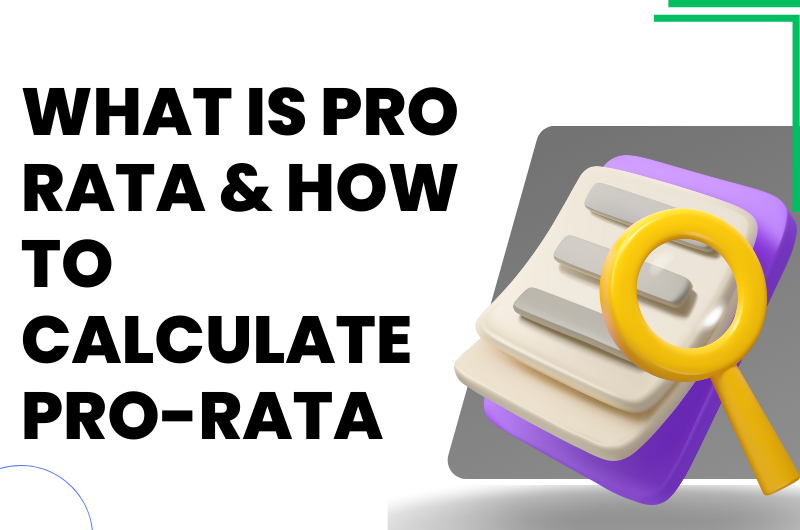“Pro Rata” is a term you might come across when you’re looking over your business records for the first time. Also, you may have heard this phrase while looking for a new job. Sometimes, if it’s not a full-time job, the stated pay amount is pro-rata. This is also an important part of the job.
In this short blog, we’ll talk about what is pro rata and How to Calculate Pro-Rata Salary, holidays, and more. So let’s start with basic understanding first.
What is Pro Rata?
It comes from Latin and means “in proportion” or “at a proportional rate.” If you are given something on a pro-rata system in accounting, it means that you are given a certain amount based on your share of the whole. The number of hours you worked is used to figure out your pro-rata pay.
Suppose your salary is £20,000 pro-rata for a 40-hour week, but you only worked 30 hours. You would get £15,000 instead of your pay. That is, if you work on it, you get a part of a full-time pay.
How to Calculate Pro-Rata Salary?
Please keep in mind that the below method doesn’t always give accurate answers. Because of this, you should use the number of hours you worked instead of days to figure this out. So, it’s better to figure it out as pay instead of salary. You can also use online tools instead of doing the maths by hand.
To calculate your pro-rata share of the salary, the basic formula is as follows:
Pro-Rata Salary = Annual salary / Hourly rate x Actual work hours
Or
Hourly rate = Annual salary of full-time employee / Total hours in the working week
Pro-Rata Salary = Hourly rate x Hours of pro-rata worker
When you work part-time, you get paid a wage that is based on how many hours you work each week. To get this number, split your yearly salary by the number of full-time hours you work and then increase that number by the number of hours you actually work. In return for your time at work, this will give you an idea of how much of your set pay you can expect to get.
For example, if a job pays £30,000 a year for full-time work (40 hours a week), then part-time workers who work 25 hours a week would make about £18,750 a year (£30,000 ÷ 40 x 25).
If someone joins your team part-time or full-time in the middle of the fiscal year, their pay would have to be split up based on the time left in the year. Also, if they start in the middle of the month and get a set salary every month, you need to figure out how much they made each day and pay them back for the days they worked during that period.
How to Calculate Pro-Rata Wage?
If you work 40 hours a week and get paid £4,000, it’s easy to figure out how much you make an hour: £4,000 / 40 = £100. Once you know your hourly rate, increase it by the number of hours you’ve worked to get your pro-rata pay.
15 hours x £100= £15,00
How to Calculate the Pro Rata Holiday?
You are also eligible for vacations if you work this way. So let’s figure them out too. It’s easy to figure out your pro-rata leave. A full-time worker is required to take 5.6 weeks of vacation each year, which is equal to 28 days. To figure it out, just increase the number of days you work each week by 5.6.
Let’s say you are a pro-rata worker who only works three days a week. Your vacation time will be 16.8 days (3 x 5.6).
Working on a Pro-rata Basis
The Part-Time Workers Regulations say that part-time workers will get the same benefits as full-time workers. Which means that if full-time workers get a pension, you should also give one to people who work part-time.
You can figure out how many days of vacation you are entitled to on gov.uk if you need an online pro-rata holiday tool.
Advantages and Disadvantages Of Hiring Employees On Pro-rata Basis
It can help your small business save money on HR costs. Here are some of the good things about it:
- It saves payroll costs
- Less outgoing on employees’ benefits
- Flexibility during busy periods
In addition to these pros, there are also some cons you should think about:
- Lack of commitment
- Higher turnover rate
- Difficult for team building
Quick Wrap-Up
We trust that you now have a sufficient understanding of what exactly pro-rata is as well as how the calculation works. If you are an employer or the owner of a small company, one of the best methods to cut the amount you spend on payroll and save money is to make use of the services of your workers on a pro-rata basis. Having said that, you must keep in mind that it comes with its own set of challenges and restrictions. In addition, in order to prevent legal issues, you need to be sure that you are correctly calculating the pro-rata income, wages, holiday pay, and benefits for your employees.


